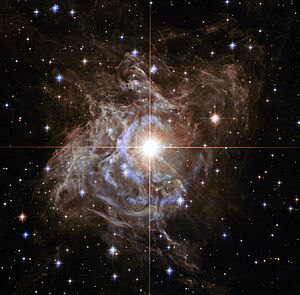Cepheid variable facts for kids

Cepheids are a special type of super bright variable stars. These stars change how bright they look over time. The amazing thing about Cepheids is that their true brightness is directly linked to how often they pulse (get brighter and dimmer).
This special link makes Cepheids like cosmic "measuring sticks." They help scientists figure out how far away things are in space, both in our own Milky Way galaxy and in other galaxies far away.
The first Cepheid star ever found was Delta Cephei in the Cepheus constellation. John Goodricke discovered it in 1784. Delta Cephei is very important because its distance is known super accurately. This is partly because it's in a star cluster and has been studied precisely by the Hubble Space Telescope.
There are different kinds of Cepheid variable stars. They have different masses, ages, and life stories:
- Classical Cepheids
- Type II Cepheids
- Anomalous Cepheids
- Dwarf Cepheids
Contents
Types of Cepheids
Classical Cepheids
Classical Cepheids are also known as Population I Cepheids. These are young, bright variable stars that pulse very regularly. Their pulses can last from a few days to several months.
Classical Cepheids are much bigger and brighter than our Sun. They can be 4 to 20 times the Sun's mass and up to 100,000 times brighter! These stars are yellow supergiants. As they pulse, their size changes by about 25%. For a star like I Carinae, this means its size changes by millions of kilometers during each pulse!
Type II Cepheids
Type II Cepheids are older stars. They pulse with periods between 1 and 50 days. These stars are usually older (around 10 billion years old) and smaller (about half the Sun's mass).
Type II Cepheids are very helpful for measuring distances. They help us find the distance to the center of our Milky Way galaxy. They also help us measure distances to globular clusters (big groups of old stars) and other galaxies.
Anomalous Cepheids
Anomalous Cepheids are another group of pulsing stars. They pulse faster, usually in less than 2 days. While they pulse as fast as another type of variable star called RR Lyrae, they are much brighter.
Anomalous Cepheids are heavier than Type II Cepheids, RR Lyrae stars, and even our Sun. Scientists are still studying if they are young stars or "blue stragglers." Blue stragglers are stars that seem younger than they should be, often because they gained mass from another star in a binary system.
Double-mode Cepheids
A small number of Cepheid stars pulse in two ways at the same time. This usually means they are pulsing in their main mode and a second, faster mode. Very rarely, some might even pulse in three modes!
Images for kids
-
Light curve of Delta Cephei, the prototype of classical cepheids, showing the regular variations produced by intrinsic stellar pulsations
-
Light curve of κ Pavonis, a Type II cepheid, recorded by NASA's Transiting Exoplanet Survey Satellite (TESS)
See also
 In Spanish: Estrella variable Cefeida para niños
In Spanish: Estrella variable Cefeida para niños






